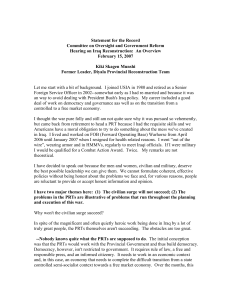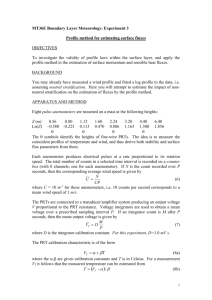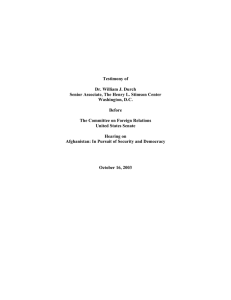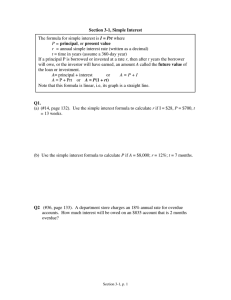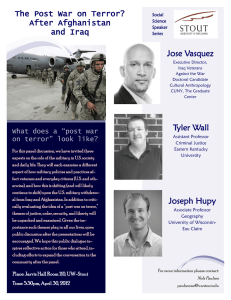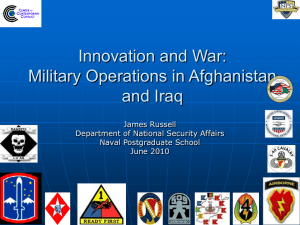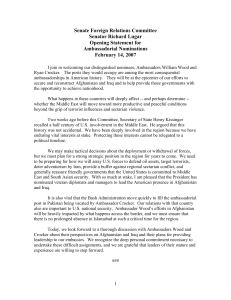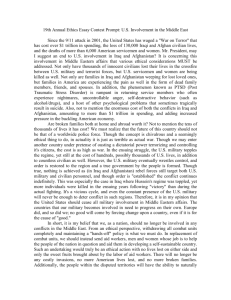Document 11055351
advertisement
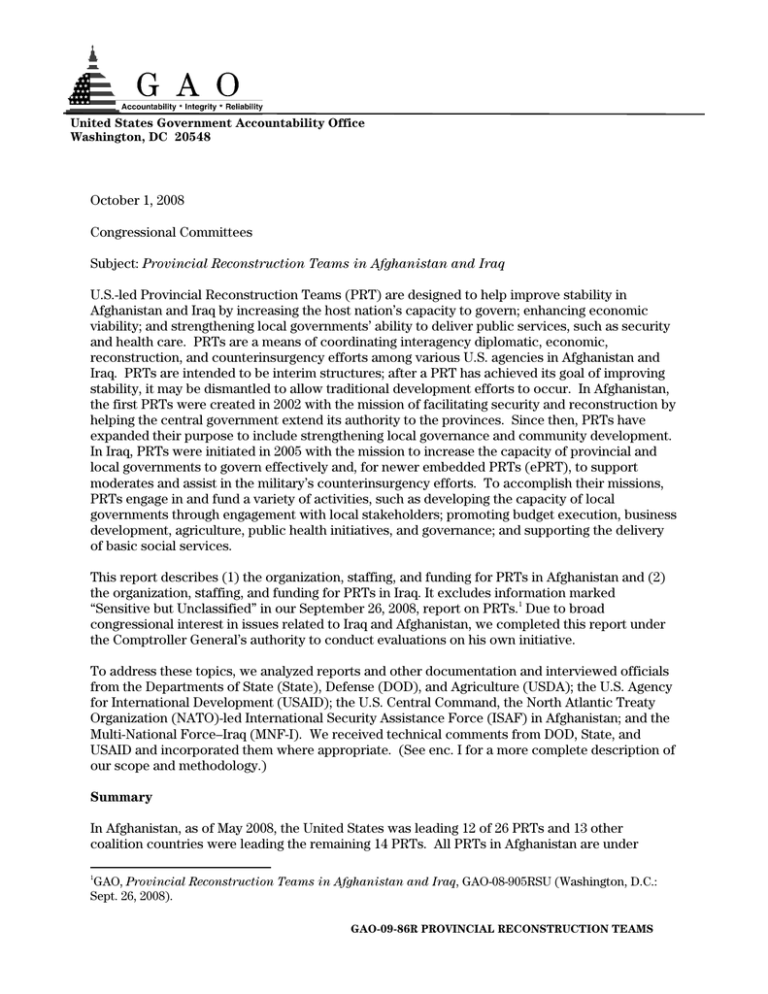
United States Government Accountability Office Washington, DC 20548 October 1, 2008 Congressional Committees Subject: Provincial Reconstruction Teams in Afghanistan and Iraq U.S.-led Provincial Reconstruction Teams (PRT) are designed to help improve stability in Afghanistan and Iraq by increasing the host nation’s capacity to govern; enhancing economic viability; and strengthening local governments’ ability to deliver public services, such as security and health care. PRTs are a means of coordinating interagency diplomatic, economic, reconstruction, and counterinsurgency efforts among various U.S. agencies in Afghanistan and Iraq. PRTs are intended to be interim structures; after a PRT has achieved its goal of improving stability, it may be dismantled to allow traditional development efforts to occur. In Afghanistan, the first PRTs were created in 2002 with the mission of facilitating security and reconstruction by helping the central government extend its authority to the provinces. Since then, PRTs have expanded their purpose to include strengthening local governance and community development. In Iraq, PRTs were initiated in 2005 with the mission to increase the capacity of provincial and local governments to govern effectively and, for newer embedded PRTs (ePRT), to support moderates and assist in the military’s counterinsurgency efforts. To accomplish their missions, PRTs engage in and fund a variety of activities, such as developing the capacity of local governments through engagement with local stakeholders; promoting budget execution, business development, agriculture, public health initiatives, and governance; and supporting the delivery of basic social services. This report describes (1) the organization, staffing, and funding for PRTs in Afghanistan and (2) the organization, staffing, and funding for PRTs in Iraq. It excludes information marked 1 “Sensitive but Unclassified” in our September 26, 2008, report on PRTs. Due to broad congressional interest in issues related to Iraq and Afghanistan, we completed this report under the Comptroller General’s authority to conduct evaluations on his own initiative. To address these topics, we analyzed reports and other documentation and interviewed officials from the Departments of State (State), Defense (DOD), and Agriculture (USDA); the U.S. Agency for International Development (USAID); the U.S. Central Command, the North Atlantic Treaty Organization (NATO)-led International Security Assistance Force (ISAF) in Afghanistan; and the Multi-National Force–Iraq (MNF-I). We received technical comments from DOD, State, and USAID and incorporated them where appropriate. (See enc. I for a more complete description of our scope and methodology.) Summary In Afghanistan, as of May 2008, the United States was leading 12 of 26 PRTs and 13 other coalition countries were leading the remaining 14 PRTs. All PRTs in Afghanistan are under 1 GAO, Provincial Reconstruction Teams in Afghanistan and Iraq, GAO-08-905RSU (Washington, D.C.: Sept. 26, 2008). GAO-09-86R PROVINCIAL RECONSTRUCTION TEAMS ISAF’s operational command, but individual nations, including the United States, lead PRTs and determine their size and structure. U.S.-led PRTs in Afghanistan are led by DOD and are composed primarily of U.S. military personnel. As of April 2008, 10 of the 12 U.S.-led PRTs included 88 or more military personnel—the majority of whom provide security and other support for the PRTs—and 3 civilian personnel from State, USAID, and USDA. The total number of U.S. government personnel assigned to U.S. PRTs in Afghanistan increased slightly from 1,023 personnel in 2007 to 1,055 personnel in 2008—which includes 1,021 military personnel from DOD 2 and 34 civilian personnel from State, USAID, and USDA. DOD is responsible for paying nearly all of the costs associated with operating PRTs, such as providing their security and life support. However, DOD officials reported that DOD does not track PRT operating costs separately from other operational costs for Afghanistan. State, USAID, and USDA do not reimburse DOD for its 3 support to civilian PRT officials in Afghanistan. PRTs have one source of programmatic funding available for projects in Afghanistan. PRT commanders can approve the use of funds for projects 4 under DOD’s Commander’s Emergency Response Program (CERP) up to $25,000 per project. PRTs in Afghanistan may also coordinate with other U.S.-funded programs, including other commanders’ CERP projects and USAID programs, such as the Local Governance and Community Development project. In Iraq, as of August 2008, the United States was leading 28 of 31 PRTs and other coalition countries were leading 3 PRTs. • As of August 2008, three types of U.S.-led PRTs were operating in Iraq: 11 PRTs at the provincial level of government; 13 ePRTs embedded with U.S. brigade combat teams and operating in local governments in Baghdad, Anbar, Babil, and Diyala provinces; and 4 Provincial Support Teams (PST), which are smaller PRTs that cannot be based in the intended province due to security concerns. PRTs and ePRTs are a joint State and DOD mission, operating under the command of both the Ambassador and the MNF-I Commanding General. All U.S. PRTs and ePRTs in Iraq are led by the State Department and consist primarily of civilian personnel. The teams, however, rely heavily on U.S. military forces for their security, food, housing, and other support. The Office of Provincial Affairs at the U.S. embassy in Baghdad directs and supports the operations of PRTs and ePRTs, providing political and economic direction to team members. The military commander has authority over the security and movement of ePRTs; many others provide security for PRTs that are colocated with U.S. military units. • According to State and DOD officials, the number of personnel assigned to PRTs and ePRTs in Iraq increased from an estimated 100 to 125 personnel in early 2007 to about 450 in July 2008. This increase was the result of the Administration’s decision in January 2007 to create 5 ePRTs and to increase the size of PRTs in support of The New Way Forward. DOD and 2 Civilian agencies had filled all but 1 of their 35 positions as of May 2008. 3 USAID provides more than $23 million to fund the PRT air fleet, which provides air transportation to PRTs. 4 CERP provides military commanders with funds to allow them to respond to urgent humanitarian and reconstruction needs. CERP projects or activities that require funding above $25,000 must be approved by the PRT commander’s superiors at the level of the task force or the Commanding General or his designee, depending on the level of funding requested. 5 In response to escalating violence in Iraq, the President in January 2007 announced a new strategy—The New Way Forward—that established a new phase in U.S. operations in Iraq that would last until July 2008. Page 2 GAO-09-86R PROVINCIAL RECONSTRUCTION TEAMS civilian agencies have staffed the PRTs with a mix of U.S. government employees— permanent and temporary—and contractors. • State reimburses DOD for some operating costs of ePRTs and most PRTs, based on a quarterly estimate for each PRT member. State’s reimbursements do not cover the costs of PRT security and transportation provided by the U.S. military. According to DOD, as of April 2008, State had reimbursed $11 million to DOD for operating costs—$5.9 million for fiscal year 2007 and $5.1 million for the first quarter of fiscal year 2008. State had also obligated $125 million for PRT movement security from September 2005 through May 2008 for PRTs in Iraq that are not embedded with U.S. military units or do not have access to military movement assets. PRTs in Iraq have two sources of programmatic funding available—the jointly administered Quick Response Fund used by State and USAID, which is designed to accelerate economic, social, and civil society development within the Iraqi provinces, and State’s Provincial Reconstruction Development Council fund, which pays for small-scale infrastructure projects at the provincial level. PRTs in Iraq also may coordinate with other U.S.-funded programs, such as USAID’s Local Governance Program. Background In Afghanistan, PRTs were established by the U.S.-led coalition as part of Operation Enduring Freedom (OEF). PRTs evolved from humanitarian assistance teams established by the U.S. military in 2002 after the overthrow of the Taliban. According to the International Security 6 Assistance Force Provincial Reconstruction Team Handbook, these teams, known as Coalition Humanitarian Liaison Cells, consisted of 10 to 12 U.S. military personnel. These teams provided information to the U.S. military on humanitarian needs and implemented small DOD-funded projects to build trust and confidence among the local population. According to a 2005 United States Institute for Peace report, PRTs expanded the humanitarian liaison cell concept by adding a force protection component and representatives from U.S. civilian agencies. The United States established the first PRT in Gardez as part of Operation Enduring Freedom in 2002. 7 In 2003, ISAF began to expand its authority throughout Afghanistan. ISAF was formed under a United Nations (UN) mandate in December 2001 to assist the government of Afghanistan in creating a secure environment to enable reconstruction. From 2003 to 2006, ISAF created 8 PRTs, while Operation Enduring Freedom established 17 additional PRTs and transferred them to ISAF. All PRTs came under ISAF’s command on October 5, 2006, when ISAF assumed authority over eastern Afghanistan from the U.S.-led coalition and the United States assumed command of ISAF’s Regional Command East. 6 The ISAF PRT handbook provides information, guidance, and best practices to PRTs in Afghanistan. It also articulates the mission of PRTs in Afghanistan, which is to assist the government of Afghanistan in extending its authority to create a stable and secure environment and enable security reform and reconstruction. 7 ISAF was initially led by individual nations that volunteered for 6-month tours of duty. In 2003, NATO assumed leadership of ISAF and the United Nations extended ISAF’s mandate to cover all of Afghanistan. Page 3 GAO-09-86R PROVINCIAL RECONSTRUCTION TEAMS As of May 2008, the United States was leading 12 of the 26 PRTs operating in Afghanistan, and 13 8 different ISAF nations were leading the remaining 14 PRTs (see fig.1). Figure 1: Locations of PRTs and Regional Commands in Afghanistan, as of May 2008 PRTs in Iraq evolved from small State Department-led provincial support teams located in 15 of Iraq’s 18 provinces. In 2005, the U.S. embassy conducted a comprehensive review of the provincial support teams and found that they were not able accomplish their mission due to inconsistent MNF-I support and weak coordination between MNF-I and the U.S. embassy, among other things. As a result, MNF-I and State developed a follow-on initiative to (1) ensure coordination between DOD and State in strengthening the capabilities of provincial governments, (2) assist in the coordination of U.S. reconstruction and development efforts, and (3) provide enhanced reporting on political and economic policy goals. State and MNF-I decided to create large, multidisciplinary PRTs with revised objectives and a joint DOD and State mission. In addition, the U.S. embassy and MNF-I established a National Coordination Team to provide strategic guidance to PRTs, direct their operational activities, and provide them with logistical and administrative support. PRTs took on the task of assisting provincial governments develop the political and economic environment within the province. In November 2005, State began 8 In addition to personnel from the lead nation, some PRTs also include personnel from other ISAF nations. Page 4 GAO-09-86R PROVINCIAL RECONSTRUCTION TEAMS establishing PRTs in Ninewa, Babil, Kirkuk, and Baghdad. By the end of 2006, the program 9 expanded to a total of 7 U.S.-led and 3 coalition-led PRTs. In February 2007, as part of The New Way Forward, State and DOD began creating 14 ePRTs to support the counterinsurgency operations of U.S. brigade combat teams, in addition to existing PRT duties. State, DOD, and other U.S. civilian agencies deployed about 325 personnel to the ePRTs. The objectives of these teams included bolstering moderates, promoting reconciliation, and building the capacity of the Iraqi government. In May 2007, the embassy established the Office of Provincial Affairs with an ambassador-level coordinator to oversee the PRT program. 10 As of August 2008, there were 14 PRTs, 13 ePRTs, and 4 PSTs throughout Iraq. Of these, 3 PRTs are led by coalition members in Irbil, Basra, and Dhi Qar province; the United States leads the remaining teams. The ePRTs are embedded with U.S. brigade combat teams and operate at the local level. According to State, PSTs have not become PRTs because they serve provinces that lack the security necessary for a permanent PRT presence. Instead, PSTs are located on military bases and travel to their provinces as needed. Organization, Staffing, and Funding for PRTs in Afghanistan This section provides information on the organization, staffing, and funding for PRTs in Afghanistan. Organization All PRTs are under ISAF’s operational command, but individual nations, including the United States, lead PRTs and determine their size and structure. U.S.-led PRTs report through the U.S. military chain of command. ISAF has a regional command structure, with the United States assuming command of the eastern region of Afghanistan, Regional Command East. The U.S. division in charge of Regional Command East is also within the U.S. military’s chain of command (see fig. 2). According to a DOD official, PRTs report directly to task forces, which are brigade 11 combat teams. Task forces, in turn, report to the U.S. division at Regional Command East, 12 which then reports to the U.S. Central Command. According to officials from State, USAID, and USDA, the civilian officials assigned to PRTs report to their agencies for administrative matters; for example, a State official at the U.S. embassy conducts performance ratings for State officials assigned to PRTs. 9 Coalition members who run PRTs are Italy, South Korea, and the United Kingdom. 10 According to State, 2 ePRTs in Baghdad merged into 1 ePRT in January 2008. 11 The 101st Airborne Division assumed authority for Regional Command East on April 10, 2008. 12 U.S. Central Command is the unified command with responsibility for the area between the European and Pacific commands. Page 5 GAO-09-86R PROVINCIAL RECONSTRUCTION TEAMS Figure 2: Chain of Command for PRTs in Afghanistan In most cases, U.S.-led PRTs in Afghanistan are led by a military commander who works with an interagency management team. These PRTs consist mainly of military personnel who support PRT operations (see fig. 3). Page 6 GAO-09-86R PROVINCIAL RECONSTRUCTION TEAMS Figure 3: Structure of U.S.-led PRTs in Afghanistan • Ten of the 12 U.S.-led PRTs are managed by an interagency team composed of a military officer, who is the PRT commander, and one representative each from State, USAID, and 13 USDA. Military and civilian officials indicated that the PRT commander is “first among equals” because the commander has authority over all security decisions. According to an official at USAID, the three civilian officials in the leadership team constitute the only 14 U.S. civilians at most PRTs. • As of April 2008, 10 of the 12 U.S.-led PRTs included 88 or more military personnel, while the remaining 2 PRTs consisted of 55 and 63 military personnel. According to a DOD official, staffing for each PRT depends on the security environment. Under DOD’s notional staffing plan, about 80 percent of the military personnel assigned to a PRT are in a support role—about 50 percent provide security and about 30 percent provide service and operational support. The remaining 20 percent serve as the PRT commander, civil affairs officers, engineers and non-commissioned officers. In contrast, military personnel 13 The two exceptions are the PRTs in Bagram and Panjshir. According to the State Department, the PRT in Bagram does not have a State position because it is colocated with the 101st Airborne Division, the U.S. military division in Afghanistan, which has a State official assigned to it. The PRT in Panjshir is co-led by a State official and military officer; according to an official at the PRT, this leadership structure is due to the secure environment and the local population’s preference for civilian leadership. 14 At 1 U.S.-led PRT and 2 international-led PRTs, USAID has an additional staff member to implement its Alternative Development Program. Page 7 GAO-09-86R PROVINCIAL RECONSTRUCTION TEAMS who provide security or other support for PRTs in Iraq are not counted among the PRT’s staff. • Some PRTs also include four to five Afghan citizens, who may serve as interpreters, liaisons with the Afghan Ministry of Interior, or additional USAID staff. In Afghanistan, PRTs perform development, reconstruction, and governance activities, and serve a monitoring and reporting function. Afghanistan has one of the world’s highest maternal mortality rates and a life expectancy at birth of about 44 years. To help meet the country’s 15 significant needs, PRT projects include schools, health clinics, and roads; efforts to build provincial governments’ capacity by helping provincial officials develop basic management skills; and facilitating communication between the provincial and central governments. For instance, according to the ISAF PRT Handbook, the PRT in Zabul province helped arrange a visit to Qalat by the Minister of Health, which was the first time any minister in the current national government had visited the province. PRT representatives also participated in consultations on the Afghanistan National Development Strategy, the Afghan government’s 5-year development framework. In addition, according to State and USAID officials, PRTs serve a monitoring and reporting function, as PRT members report to their agencies on local conditions. Members of the PRT leadership team have different roles. According to DOD, the PRT commander is responsible for PRT security, coordination of interagency efforts, and provincial and district government capacity-building. The USAID field program officer carries out activities for USAID’s PRT-managed program. The field program officer facilitates, coordinates, monitors, and reports on all USAID projects in the area, and identifies local development needs and builds relationships with local leaders. According to a State official, the State representative at a PRT reports to the embassy on the political situation in the province, works with local government officials, and serves as a political advisor. The USDA official serves as an agricultural advisor, and trains and mentors Afghan agricultural officials in developing and implementing agricultural activities. Staffing Levels and Process In Afghanistan, DOD, State, USAID, and USDA provide U.S. staff for PRTs led by the United States and other countries. DOD provides most of the staff since U.S.-led PRTs are primarily composed of military personnel (see table 1). From 2007 to 2008, the number of military personnel at U.S.-led PRTs increased from 994 to 1021, while the number of U.S. civilians serving at U.S.- and non-U.S.-led PRTs rose from 45 to 49. 15 See GAO, Afghanistan Reconstruction: Progress Made in Constructing Roads but Assessments for Determining Impact and a Sustainable Maintenance Program Are Needed, GAO-08-689 (Washington, D.C.: July 8, 2008). Page 8 GAO-09-86R PROVINCIAL RECONSTRUCTION TEAMS Table 1: Number of U.S. Military and Civilian Personnel Assigned to PRTs in Afghanistan, 2007-2008 DOD Statea USAIDb USDA TOTAL 2008 U.S.-led PRTs 1021 11 11 12 1055 Other PRTs N/A 7 8 0 15 1021 18 19 12 1070 994 11 11 7 1023 N/A 7 9 0 16 994 18 20 7 1039 Total 2007 U.S.-led PRTs Other PRTs Total Source: State, DOD, USAID, and USDA data. Notes: a State staffing data for fiscal year 2007 were as of April 2007. b USAID staffing data are cumulative for fiscal year 2007; thus, positions that may have been occupied for a portion of the year are counted as filled. As of April 2008, DOD had 1,021 military personnel serving in PRTs in Afghanistan. According to a military official, all PRT commanders are from the Navy or Air Force, and Navy PRT commanders are selected by the Chief of Naval Operations, while Air Force PRT commanders are recruited through a worldwide bulletin. According to a DOD official, DOD obtains PRT staff through the joint sourcing process, in which the armed services provide personnel in response to a request for forces from the U.S. Central Command. According to DOD, as of September 2008, U.S. military personnel serve in non-U.S.-led PRTs to provide management and oversight of the Commander’s Emergency Response Program (CERP), a DOD program that provides military commanders with funds to allow them to respond to urgent humanitarian and reconstruction needs. Civilian agencies had 49 personnel assigned to U.S.-led and non-U.S.-led PRTs in Afghanistan, as 16 of May 2008. All but 1 of the 35 civilian positions at U.S.-led PRTs were filled as of May 2008. In addition, 15 civilian officials were serving at non-U.S.-led PRTs—7 from State and 8 from 17 USAID. Further, State, USAID, and USDA also had a total of 12 staff assigned to the embassy 18 and mission in Kabul to support PRTs. • As of May 2008, State had 18 personnel serving on PRTs. According to a State official, all State representatives in PRTs are Foreign Service officers, and State relies on the Foreign Service bidding process to staff officials to PRTs. State offers a variety of incentives to 16 State had filled all 11 of its positions at U.S.-led PRTs, USAID had 11 of 12 positions filled, and USDA had filled all 12 of its positions. 17 According to USAID and State officials, their agencies provide staff to international-led PRTs upon the lead nation’s request. 18 State has five U.S. officials, including an official who travels to PRTs to cover staffing gaps. USAID has six officials, and USDA has one. Page 9 GAO-09-86R PROVINCIAL RECONSTRUCTION TEAMS attract personnel to serve in Afghanistan. For instance, State officials serving in Afghanistan receive allowances and differentials, such as danger pay and post differential; they also receive two 1-week regional rest breaks and two 2- to 3-week rest and relaxation leaves. • As of May 2008, 19 USAID personnel were serving on PRTs in Afghanistan. According to USAID officials, USAID representatives at PRTs are either direct hires—which include 19 Foreign Service officers, Foreign Service Limited officers, and civil service employees—or 20 personal service contractors. To staff Foreign Service officers to PRTs, a USAID official reported relying on the annual staff bidding process. For personal service contractors, USAID posts continuous position announcements, according to a USAID official. USAID has identified Afghanistan as a critical priority country and offers incentives for service in Afghanistan, including allowances and differentials, two regional rest breaks, and two rest and relaxation leaves. In addition, according to USAID officials, Foreign Service officers who serve on PRTs in Afghanistan receive priority consideration on their next assignment. • As of May 2008, USDA had 12 employees assigned to PRTs. According to USDA, USDA primarily relies on its civil service employees to fill positions for agricultural advisors at PRTs; civil service employees are sent to Afghanistan on 1-year details. In addition, USDA reported that some positions are filled by USDA Foreign Agricultural Service staff and temporary term-limited employees. To fill PRT positions, USDA posts detail opportunities for civil service employees and recruits temporary term-limited employees. Applicants selected to serve at PRTs receive a package of allowances and differentials. In January 2008, the U.S. Ambassador to Afghanistan requested an additional 16 State and 17 USAID staff to support PRTs in Afghanistan. In the request, the Ambassador proposed that some of these staff be placed at regional commands and brigades to provide functional expertise as needed. According to a USAID official, in fiscal year 2008, USAID plans to add 8 regional PRT officials; in fiscal year 2009, USAID intends to add 12 regional PRT officials and 3 regular PRT officials. According to a State official, State plans to request 20 PRT-related staff in fiscal years 2008 and 2009. Operating Costs and Programmatic Funding DOD is responsible for paying nearly all of the costs associated with operating PRTs, such as providing security, life support, sustainment, and housing. According to DOD officials, the department does not track PRT operating costs separately from other operational costs for Afghanistan. State, USAID, and USDA do not reimburse DOD for its support to civilian PRT officials in Afghanistan. USAID provides more than $23 million to fund the PRT air fleet, which provides air transportation to PRTs. According to a DOD official, DOD has developed a rough estimate of $20 million as the cost of establishing a PRT in Afghanistan. The official informed us that the department provides this figure to ISAF members interested in starting a new PRT in Afghanistan, but the figure does not necessarily reflect what it costs the United States to run a PRT in Afghanistan. 19 Foreign Service Limited employees perform inherently governmental functions at USAID missions. 20 Personal services contractors are generally treated like civil service employees and often perform the same or similar work as these employees. Page 10 GAO-09-86R PROVINCIAL RECONSTRUCTION TEAMS PRTs have one source of programmatic funding available for projects in Afghanistan. PRT 21 commanders can approve the use of funds for CERP projects up to $25,000. A DOD program, CERP provides military commanders with funds to allow them to respond to urgent humanitarian and reconstruction needs. In fiscal year 2007, according to a U.S. military database, $109 million in CERP funding was obligated to support PRT projects. Although the PRT commander approves funding, he or she does not obligate CERP funds; the CERP project purchasing officer obligates funds through contracts. PRT-funded CERP projects may include efforts to improve health care, water and sanitation, transportation, and education. PRTs in Afghanistan also may coordinate with or provide advice to other U.S.-funded programs, including other commanders’ CERP projects, USAID’s Local Governance and Community Development project, and other USAID programs. • Commander’s Emergency Response Program (CERP): According to officials, other military commanders within a PRT’s area of operations may also have authority over CERP funds. To prevent duplication of effort, CERP guidance calls for military commanders to coordinate CERP projects with PRTs. These military commanders and PRTs may engage in projects related to water and sanitation, rule of law, and repair of property damaged by U.S., coalition, or supporting military operations, among other projects. • Local Governance and Community Development Program: Funded and managed by USAID, this nationwide program operates in 20 of Afghanistan’s 34 provinces. Its objectives include building local governments’ capacity to deliver services and address the needs of the local populace, and encouraging community participation in development projects. USAID received about $110 million for this program in fiscal year 2007 and $63 million in fiscal year 2008. USAID field program officers in PRTs monitor this program’s activities in their provinces, and may design and submit activity proposals to the mission in Kabul, as long as the proposals are consistent with the program’s goals. However, according to a USAID official, USAID field program officers in PRTs do not have final authority to decide the program’s activities; rather, USAID officials at the mission in Kabul are responsible for making such decisions about the program. According to a USAID representative, USAID field program officers work closely with the PRT leadership team, provincial government, and implementing partners to develop and implement program activities. For instance, to help build local government capacity, one PRT held a 3-day training workshop for district administrators that focused on basic administrative and management skills. • Other USAID programs: PRTs may also coordinate with and advise other USAID-funded programs. USAID’s programs in Afghanistan include the Alternative Development Program and national development programs in road construction, democracy, and health. Part of the U.S. government’s counternarcotics efforts in Afghanistan, the Alternative Development Program seeks to create a sustainable economic alternative to poppy cultivation. USAID obligated about $121 million to this program in fiscal year 2006 and approximately $228 million in fiscal year 2007, and received $176 million for the program in fiscal year 2008. Technical officers who manage local program activities are colocated with 1 U.S.-led PRT and 2 international-led PRTs, using the PRT as a platform for their work in the field. According to a USAID official, although Alternative Development Program technical officers 21 Projects or activities that require funding above $25,000 must be approved by the PRT commander’s superiors at the level of the task force or the Commanding General or his designee, depending on the level of funding requested. Page 11 GAO-09-86R PROVINCIAL RECONSTRUCTION TEAMS are not considered part of the PRT leadership team, the officers keep the PRT leadership team apprised of program activities in the area. PRTs also may influence other USAID national development programs, such as programs for road construction, democracy, and 22 health. USAID obligated about $638 million in fiscal year 2006 and $1.14 billion in fiscal year 2007 to such national development programs in Afghanistan. In fiscal year 2008, USAID received $706 million for these programs. Organization, Staffing, and Funding for PRTs in Iraq This section provides information on the organization, staffing, and funding of PRTs in Iraq. Organization PRTs and ePRTs are a joint State and DOD mission, operating under the command of both the Ambassador and the MNF-I Commanding General. In Iraq, U.S. PRTs are led by the State Department but rely heavily on U.S. military forces for their security, food, housing, and other support, particularly the 13 ePRTs and 12 of the 18 PRTs that are colocated with U.S. military units. All U.S.-led PRTs not located at the embassy or a regional embassy office rely solely on the military for their support. The Office of Provincial Affairs at the U.S. embassy in Baghdad provides guidance and supports the operations of the PRTs and ePRTs, providing political and economic direction to team members. The military commander has authority over security and movement of ePRTs. Many others also provide security for PRTs that are located on the commander’s forward operating base. Other agencies that contribute personnel to the PRT program include USAID, USDA, and the Department of Justice. All team members report to the PRT team leader; some non-State Department team members also report to their home agencies. As of August 2008, the size of PRTs ranged from 10 to 45 personnel at each location; ePRTs consisted of 10 to 20 personnel; and PSTs had up to 10 personnel. PRTs and ePRTs are led by a State Department Foreign Service officer with a core group of military and civilian personnel. The deputy team leaders for PRTs are usually military personnel, while the deputy team leaders for ePRTs are from USAID. The team leader is responsible for implementing the joint coalition PRT initiative at the provincial or local level of government. The deputy team leaders are responsible for assisting the team leader, functioning as the team leader’s chief of staff, and managing day-to-day operations. The bilingual-bicultural advisor is an expatriate Iraqi contracted by DOD to advise PRTs and ePRTs and their Iraqi counterparts. Bilingual-bicultural advisors speak fluent English and either Arabic or Kurdish; they function as a key interface between PRT members and Iraqi government officials. The majority of PRTs rely on U.S. military units for their security; however, a number of PRTs use personal security contractors for movement security. For perimeter security, PRTs rely on the U.S. military when located on their bases, on coalition partners when located on their bases, and on State assets in Irbil. PRTs and ePRTs also include specialists in specific areas such as city management, agriculture, banking and finance, and public health. Other U.S. civilian agencies—USDA and the Departments of Commerce and Justice—may also assign their personnel to PRTs as technical advisors in areas such as agriculture, business development, and the rule of law. PRTs and ePRTs aim to bolster moderates, support U.S. counterinsurgency strategy, promote reconciliation and shape the political environment, support economic development, and build the capacity of Iraqi provincial governments to help transition Iraq to self-sufficiency. PRTs also advise provincial 22 USAID officials at PRTs have the authority to approve USAID grants up to $10,000. Page 12 GAO-09-86R PROVINCIAL RECONSTRUCTION TEAMS government officials so that they can more efficiently spend the provincial government’s budget and implement needed services. Staffing Levels and Process According to State, the number of personnel assigned to PRTs in Iraq increased from an estimated 100 to 125 personnel in early 2007 to about 450 in July 2008. This large increase in personnel resulted from the Administration’s decision in January 2007 to create ePRTs and to increase the size of the PRT program in support of The New Way Forward. In February 2007, State and DOD agreed to add 323 positions to PRTs and ePRTs in three phases: (1) 40 personnel from State, USAID, and DOD to create the initial 10 ePRTs by March 31, 2007; (2) 133 personnel, including 99 military and civilian personnel from DOD, by September 30, 2007; and (3) 150 specialists—mostly civilians from State, USAID, and USDA—to ePRTs by December 30, 2007 (see fig.4). According to State, U.S. agencies generally met the time frames for filling the additional positions. Figure 4: Phased Increase in PRT and ePRT Personnel in Iraq According to State and DOD officials, DOD agreed to staff temporarily many of the civilian agency positions during the second phase of the expansion until State received its supplemental funding in the second half of 2007. According to State, State has hired personnel to fill the majority of the 99 positions that DOD had filled during the second phase. As of July 2008, the U.S. government had about 450 personnel deployed to U.S.-led PRTs in Iraq— 230 from State; 95 from USAID; 90 from DOD; and 35 from other agencies, including the Departments of Commerce, Justice, and Agriculture. DOD also provided a significant number of military personnel who supported PRT operations but were not counted as PRT personnel. Page 13 GAO-09-86R PROVINCIAL RECONSTRUCTION TEAMS • As of July 2008, State has about 230 personnel deployed to PRTs and ePRTs in Iraq—75 23 Foreign Service officers, 115 temporary government employees, 30 contractors, and 10 employees in other capacities. Foreign Service officers fill all team leader positions. For temporary positions, the Office of Provincial Affairs notifies ITAO of technical needs at PRTs, and ITAO announces positions for expertise in areas such as city management, public works, and transportation. Once hired, these temporary government employees must receive medical, security, ethics clearances, and training before departure to Iraq. According to a State official, the contractors are not U.S. government employees; they provide technical expertise as needed. • As of July 2008, USAID has about 95 personnel in Iraq—a mix of 35 Foreign Service officers, civilian personnel, and personal services contractors and 60 institutional contractors. To staff Foreign Service officers to PRTs, USAID relies on the annual staff bidding process. For contractors, USAID officials said they post continuous position announcements for personal services contractors and also rely on institutional contractors. According to USAID officials, like other foreign affairs agencies, USAID has identified Iraq as a critical priority and offers incentives for service in Iraq, including allowances, differentials, two regional rest breaks, and two rest and relaxation leaves. In addition, according to State and USAID officials, Foreign Service officers who serve on PRTs in Iraq receive priority consideration on their next assignment as do State Foreign Service officers. • As of July 2008, DOD had about 90 personnel deployed to PRTs and ePRTs in Iraq—25 military personnel, 40 DOD civilians, and 25 DOD contractors who serve as bilingual24 bicultural advisors. According to DOD, under the DOD/State support agreement, DOD also provides the equivalent of 1 ½ infantry battalions—750 to 900 soldiers—to provide movement security for PRTs. DOD also provides civil affairs companies of about 40 personnel each to support each PRT’s operations. • As of July 2008, the Departments of Commerce and Justice and USDA had about 5, 10, and 20 personnel respectively supporting the PRT program. For example, the Department of Justice provides Resident Legal Advisors who help establish programs that establish the rule of law throughout Iraq. Operating Costs and Programmatic Funding For Iraq, State reimburses DOD for some operating costs of 13 ePRTs and 12 of the 18 PRTs that are colocated with U.S. military units. According to DOD, the reimbursement amount is based on a quarterly estimate for each PRT member. State’s reimbursements cover DOD support for such items as facilities, logistics, basic utilities, lodging, food, water, and sanitation; however, they do not cover the costs of PRT security and transportation provided by the U.S. military. According to DOD, as of April 2008, State had reimbursed DOD $11 million for operating costs—$5.9 million for fiscal year 2007 and $5.1 million for the first quarter of fiscal year 2008. State and DOD estimate a cost of $21.1 million for PRT operating costs for fiscal year 2008. According to State, in addition to relying on the military, PRTs may rely on personal security contractors or a 23 According to State Department officials, State was granted the authority under 5 USC 3161 to directly hire people to fill positions in temporary organizations, such as the Iraq Transition Assistance Office (ITAO). 24 In September 2008, State updated its staffing figures for bilingual-bicultural advisors and reported having 69 of these advisors in PRTs in Iraq. Page 14 GAO-09-86R PROVINCIAL RECONSTRUCTION TEAMS combination of the two to ensure the safety of their movement. According to the Bureau of Diplomatic Security, State obligated about $125 million for PRT movement security between September 2005 and May 2008. PRTs in Iraq have two sources of programmatic funding available. First, PRTs have the authority to obligate funds for projects funded through the Quick Response Fund jointly administered by State and USAID. The Quick Response Fund was established to accelerate economic, social, and civil society development within Iraqi provinces. The fund is administered by PRT staff who identify projects to build the capacity of governments to deliver services, empower women and youth, and support civil society and small businesses. For fiscal year 2007, according to State, $136 million in Economic Support Funds was allocated for the Quick Response Fund. Second, PRTs assist in identifying and executing projects under State’s Provincial Reconstruction Development Council program. According to State, this fund pays for small-scale infrastructure projects at the provincial level to strengthen the ability of provincial governments to deliver essential services and key development projects to their communities. Projects receive approval from the U.S. embassy in Baghdad and are executed by the Army Corps of Engineers. For fiscal year 2007, according to State, $600 million in Economic Support Funds was allocated for the Provincial Reconstruction Development Council program. PRTs in Iraq may also coordinate with other U.S.-funded programs, including USAID’s Local Governance Program, Community Action Program, and Community Stabilization Program; and DOD’s CERP. • The USAID representative to the PRT is expected to coordinate on USAID’s activities in the province through USAID’s Local Governance Program, which is intended to support PRT initiatives to promote diverse and representative citizen participation in provincial, municipal, and local councils. According to State, the Local Governance Program also strengthens the management skills of city and provincial administrators, local interim representative bodies, civil society organizations, and civic institutions in order to improve the delivery of essential municipal services. According to State, the Local Governance Program was allocated $90 million in Economic Support Funds in fiscal year 2007 and $54 million in fiscal year 2008. • According to State, USAID’s Community Action Program works to strengthen the links between communities and their governments. This program facilitates formal community coordination with local and provincial governments, promotes transparency and accountability at all levels, and encourages local ownership of public goods. According to USAID, the Community Action Program was allocated $70 million in Economic Support Funds in fiscal year 2007 and about $105 million in fiscal year 2008. • USAID’s Community Stabilization Program focuses on reducing the incentives for young men to participate in sectarian violence and insurgent activities. USAID selects neighborhoods and districts in consultation with the PRTs and ePRTs, brigade commanders, and community leaders. The program selects short-term projects that generate significant employment in the provision of essential services and public works. It also provides activities for Iraqi youths, such as sports tournaments, cultural events, and arts activities. The program generates longterm employment through business development, including in-kind grants to Iraqi small businesses and business skills training. The Community Stabilization Program was allocated $379 million in Economic Support Funds in fiscal year 2007 and $100 million in fiscal year 2008. Page 15 GAO-09-86R PROVINCIAL RECONSTRUCTION TEAMS • 25 In Iraq, the military is required to coordinate the use of CERP funds with the PRTs. CERP is designed to enable local commanders in Iraq and Afghanistan to respond to urgent humanitarian relief and reconstruction requirements by carrying out programs to assist the indigenous population. In fiscal year 2007, DOD obligated $898 million on CERP projects in Iraq. ----We are sending copies of this report to interested congressional committees. We will also make copies available to others on request. If you or your staff have any questions about this report, please contact me at (202) 512-8979 or christoffj@gao.gov. Judith McCloskey (Assistant Director), Valérie Nowak, Daniel Chen, Lynn Cothern, and Susan Tieh made key contributions to this report. Sincerely, Joseph A. Christoff Director, International Affairs and Trade 25 For information about CERP in Iraq, see GAO, Actions Needed to Better Guide Project Selection for Commander’s Emergency Response Program and Improve Oversight in Iraq, GAO-08-736R (Washington, D.C.: June 23, 2008). Page 16 GAO-09-86R PROVINCIAL RECONSTRUCTION TEAMS List of Congressional Committees The Honorable Carl Levin Chair The Honorable John McCain Ranking Member Committee on Armed Services United States Senate The Honorable Joseph R. Biden, Jr. Chair The Honorable Richard G. Lugar Ranking Member Committee on Foreign Relations United States Senate The Honorable Robert C. Byrd Chair The Honorable Thad Cochran Ranking Member Committee on Appropriations United States Senate The Honorable Daniel Inouye Chair The Honorable Thad Cochran Ranking Member Subcommittee on Defense Committee on Appropriations United States Senate The Honorable Patrick J. Leahy Chair The Honorable Judd Gregg Ranking Member Subcommittee on State, Foreign Operations, and Related Programs Committee on Appropriations United States Senate The Honorable Thomas R. Carper Chair The Honorable Tom Coburn Ranking Member Subcommittee on Financial Management, Government Information, Federal Services, and International Security Committee on Homeland Security and Governmental Affairs United States Senate Page 17 GAO-09-86R PROVINCIAL RECONSTRUCTION TEAMS The Honorable Ike Skelton Chair The Honorable Duncan L. Hunter Ranking Member Committee on Armed Services House of Representatives The Honorable Howard L. Berman Chair The Honorable Ileana Ros-Lehtinen Ranking Member Committee on Foreign Affairs House of Representatives The Honorable John P. Murtha Chair The Honorable C.W. Bill Young Ranking Member Subcommittee on Defense Committee on Appropriations House of Representatives The Honorable Nita M. Lowey Chair The Honorable Frank R. Wolf Ranking Member Subcommittee on State, Foreign Operations, and Related Programs Committee on Appropriations House of Representatives The Honorable Henry A. Waxman Chair The Honorable Tom Davis Ranking Member Committee on Oversight and Government Reform House of Representatives The Honorable John F. Tierney Chair The Honorable Christopher Shays Ranking Member Subcommittee on National Security and Foreign Affairs Committee on Oversight and Government Reform House of Representatives Page 18 GAO-09-86R PROVINCIAL RECONSTRUCTION TEAMS Enclosure I Objectives, Scope, and Methodology In response to congressional interest in Provincial Reconstruction Teams (PRT), GAO examined (1) the organization, staffing, and funding of U.S.-led PRTs in Afghanistan and (2) the organization, staffing, and funding of U.S.-led PRTs in Iraq. 26 To address these topics, we reviewed prior GAO reports related to Afghanistan and Iraq. We interviewed officials from the State Department (State), U.S. Department of Agriculture (USDA), and the U.S. Agency for International Development (USAID) in Washington, D.C, and the Department of Defense (DOD) at the Pentagon. In addition, we met with DOD officials at U.S. Central Command in Tampa, Florida. To describe the organization and staffing of U.S.-led PRTs in Afghanistan, we reviewed the International Security Assistance Force Provincial Reconstruction Team Handbook. In addition, we interviewed USAID and State officials that were currently serving or previously served in PRTs in Afghanistan. We also interviewed DOD, State, USAID, and ISAF officials serving in Afghanistan. We obtained staffing data from DOD, State, USDA, and USAID. To describe programmatic funding for U.S.-led PRT efforts in Afghanistan, we reviewed DOD’s standard operating procedure for the Commander’s Emergency Response Program (CERP) in Afghanistan. We obtained financial data from DOD on CERP projects managed by PRTs. We also reviewed budget data from USAID on its programmatic activities in Afghanistan. To describe operations funding for PRT efforts in Afghanistan, we obtained information from DOD, specifically the Department of the Army. We also obtained information from the Department of State, USDA, and USAID regarding their support for PRT operational costs. To describe the organization and staffing of U.S.-led PRTs in Iraq, we reviewed documentation and data from the Department of State and USAID, and the Center for Army Lessons Learned’s PRT Playbook. We also interviewed officials from DOD, the Multi-National Force–Iraq (MNF-I), and State’s Office of Provincial Affairs in the U.S. Embassy Baghdad. In addition, we attended the Department of State’s PRT training course. To describe programmatic funding for PRT efforts in Iraq, we reviewed budget information and reports from the Department of State. We also interviewed officials from the Department of State and Office of Provincial Affairs personnel in the U.S. Embassy Baghdad. To describe operations funding for PRT efforts in Iraq, we reviewed a memorandum of agreement between State and DOD and spoke with officials from both agencies. In addition, to identify the costs of security at those PRTs without a U.S. military presence, we spoke with and obtained data from State’s Bureau of Diplomatic Security. Due to time constraints, we did not travel to Afghanistan, and we did not visit PRTs in Afghanistan or Iraq. GAO staff stationed in Baghdad, Iraq, contributed to this review. 26 GAO, Securing, Stabilizing, and Reconstructing Afghanistan: Key Issues for Congressional Oversight, GAO-07-801SP (Washington, D.C.: May 2007); Securing, Stabilizing, and Rebuilding Iraq: Iraqi Government Has Not Met Most Legislative, Security, and Economic Benchmarks, GAO-07-1195 (Washington, D.C.: Sept. 4, 2007); Stabilization and Reconstruction: Actions Needed to Improve Governmentwide Planning and Capabilities for Future Operations, GAO-08-228T (Washington, D.C.: Oct. 30, 2007). Page 19 GAO-09-86R PROVINCIAL RECONSTRUCTION TEAMS Enclosure I We limited our review of the structure and operations funding of PRTs to those led by U.S. officials in Afghanistan and Iraq; we did not include PRTs led by other ISAF nations in Afghanistan or coalition countries in Iraq. However, our review of staffing and programmatic funding includes U.S. personnel and activities, civilian and military, assigned to all PRTs in Afghanistan and Iraq because appropriated U.S. funds are involved. We received technical comments from DOD, State, and USAID, and incorporated the comments where appropriate. (320624) Page 20 GAO-09-86R PROVINCIAL RECONSTRUCTION TEAMS This is a work of the U.S. government and is not subject to copyright protection in the United States. The published product may be reproduced and distributed in its entirety without further permission from GAO. However, because this work may contain copyrighted images or other material, permission from the copyright holder may be necessary if you wish to reproduce this material separately. This is a work of the U.S. government and is not subject to copyright protection in the United States. The published product may be reproduced and distributed in its entirety without further permission from GAO. However, because this work may contain copyrighted images or other material, permission from the copyright holder may be necessary if you wish to reproduce this material separately. GAO’s Mission The Government Accountability Office, the audit, evaluation, and investigative arm of Congress, exists to support Congress in meeting its constitutional responsibilities and to help improve the performance and accountability of the federal government for the American people. GAO examines the use of public funds; evaluates federal programs and policies; and provides analyses, recommendations, and other assistance to help Congress make informed oversight, policy, and funding decisions. GAO’s commitment to good government is reflected in its core values of accountability, integrity, and reliability. Obtaining Copies of GAO Reports and Testimony The fastest and easiest way to obtain copies of GAO documents at no cost is through GAO’s Web site (www.gao.gov). Each weekday afternoon, GAO posts on its Web site newly released reports, testimony, and correspondence. To have GAO e-mail you a list of newly posted products, go to www.gao.gov and select “E-mail Updates.” Order by Phone The price of each GAO publication reflects GAO’s actual cost of production and distribution and depends on the number of pages in the publication and whether the publication is printed in color or black and white. Pricing and ordering information is posted on GAO’s Web site, http://www.gao.gov/ordering.htm. Place orders by calling (202) 512-6000, toll free (866) 801-7077, or TDD (202) 512-2537. Orders may be paid for using American Express, Discover Card, MasterCard, Visa, check, or money order. Call for additional information. To Report Fraud, Waste, and Abuse in Federal Programs Contact: Congressional Relations Ralph Dawn, Managing Director, dawnr@gao.gov, (202) 512-4400 U.S. Government Accountability Office, 441 G Street NW, Room 7125 Washington, DC 20548 Public Affairs Chuck Young, Managing Director, youngc1@gao.gov, (202) 512-4800 U.S. Government Accountability Office, 441 G Street NW, Room 7149 Washington, DC 20548 Web site: www.gao.gov/fraudnet/fraudnet.htm E-mail: fraudnet@gao.gov Automated answering system: (800) 424-5454 or (202) 512-7470
